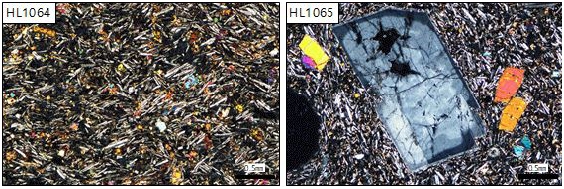
피열 퇴적층 OSL 연대분석으로부터의 후기 플라이스토세 이후 용암층 수치연대 도출법 적용 가능성: 40Ar/39Ar 연대분석을 통한 확인
초록
후기 플라이스토세 이후의 화산활동에 대한 수치연대는 종종 적절한 연대분석법의 부재로 양질의 자료를 얻지 못한다. 제주도 화산암류의 경우도 이러한 어려움이 대두되고 있다. 제주도에는 화산암류뿐만 아니라 화산활동 휴지기 동안에 쌓인 퇴적층들이 용암층들 사이에 협재되어 곳곳에 분포한다. Ahn et al. (2018)은 용암층 사이에 협재하는 교래교퇴적층을 대상으로 자기학적 방법을 이용하여 상부 용암에 의해 가열되어 도달한 온도를 정량 복원하여 퇴적층의 석영을 이용한 광여기 루미네선스(OSL) 연대가 퇴적시기가 아닌 열에 의해 OSL신호가 리셋되고 난 후의 경과시간, 즉 상부 용암의 정치 연대를 지시할 가능성을 제시하였다. 이로부터 상부 용암 추정연대는 14.8 ± 0.8 ka로 제시되었다. 본 연구는 용암 시료에 대해 전암 석기의 단계가열 40Ar/39Ar 연대분석을 통해 15 ± 5 ka로 Ahn et al. (2018)이 제시한 상부 용암의 연대와 잘 일치하는 결과를 얻어 퇴적층 OSL 연대분석을 통한 수치연대 도출법의 적용 가능성을 입증하였다. 향후 제주도의 최후기 화산활동사와 관련해 퇴적층 OSL 연대분석 및 피열온도 정량 복원이 후기 플라이스토세-홀로세 동안의 용암류의 수치연대를 새롭게 제시하는데 크게 기여할 수 있을 것이다.
Abstract
Precisely dating volcanic events since the Late Pleistocene is often difficult due to the lack of appropriate chronology. Such difficulty is encountered in the Jeju volcanics. In Jeju Island there are sedimentary deposits that are intercalated with volcanic units, as well as primary volcanic products. For the Kyorekyo Sediments that are sandwiched between two lava beds in the island, Ahn et al. (2018) estimated quantitatively paleotemperatures reached by heat of the upper lava emplacement by applying magnetic methods and explained that there were lava-heated sediments in which the OSL signal could be zeroed by the lava heat; thus, the estimated OSL ages indicate not the sedimentation age but the age of the lava emplacement resulting in 14.8 ± 0.8 ka. In this study the whole-rock-groundmass step-heating 40Ar/39Ar dating assigns a plateau age of 15 ± 5 ka to the upper lava, which shows relatively large uncertainty but is in good agreement with the lava-heated sediment OSL estimates thereby confirming the feasibility of the Ahn et al. (2018) dating approach. Future works by such lava-heated sediment OSL chronology with paleotemperature estimation have a potential to improve dating the Late Pleistocene-Holocene lavas related to the last volcanic history in Jeju Island.
Keywords:
Jeju Island, volcanism since the Late Pleistocene, 40Ar/39Ar dating, OSL dating, paleo-heating temperature키워드:
제주도, 후기 플라이스토세 이후 화산활동, 40Ar/39Ar 연대, 광여기루미네선스 연대, 피열온도1. 서 론
화산지대(volcanic field) 내 화산분출물(volcanic products)의 신뢰도 높은 수치연대(numerical age) 결과는 과거 (지표)화산활동의 시공간적 진화 추이를 정밀하게 파악하는데 기여할 뿐 아니라, 화산지대 지하의 마그마 플러밍시스템(magma plumbing system)의 특성 변동 파악, 그리고 나아가 미래 화산활동의 예측 및 관련 재해 가능성 평가를 위한 질 높은 기초자료를 제공한다(예: Schmincke, 2007; Bebbington and Cronin, 2011; Brenna et al., 2015; Leonard et al., 2017; Mahgoub et al., 2017; Bebbington, 2020).
그러나, 후기 플라이스토세 이후의 화산분출물의 경우, 그 수치연대를 정밀하게 도출해 내는 데 종종 어려움을 겪는다. 예를 들어, 가장 널리 활용되는 방사성동위원소 40Ar/39Ar 또는 K-Ar 연대분석법의 경우, 상대적으로 긴 40K의 반감기와, 때로는 매우 낮은 K 함량(현무암질/고철질 암석) 등의 원인으로 연대 결과에 높은 불확실도를 가질 수 있다(예: Chernyshev et al., 2006; Leonard et al., 2017). 방사성탄소(이하, 14C 라 함) 연대분석의 경우, 과거 수 만년 이내의 수치연대 추정에 있어 대체로 매우 높은 정확도 및 정밀도로 높은 신뢰도를 보이는 한편(예: Kuntz et al., 1986; Oppenheimer et al., 2017), 노두로부터 목편(화산분출물에 의해 생명활동이 정지되거나 고온에 의해 탄화된 것) 등의 적절한 분석대상을 찾을 수 없는 경우를 화산지대에서 흔히 볼 수 있다. 또한 이질적인 (그러나 제어 혹은 선별 불가한) 탄소 혼입 등으로 인한 추정 연대의 정확도 및 정밀도 저하가 보고되곤 한다(예: Soter, 2011; Manning and Kromer, 2012; Holdaway et al., 2018). 필요에 따라, 세계 각지의 연구자들은 후기 플라이스토세 이후 화산분출물의 보다 정확한 연대 추정을 위해 대상 물질의 특성 및 존재 빈도와 그 주변 지질환경, 그리고 보유 연대분석 기술 및 그 특화 정도에 따라 다양한 측정원리, 다양한 대상물질과 그 추출 및 준비방법 등을 검토, 적용하고, 최적화하고 있다: 예를 들어, 용암류의 고온에 의해 가열된 퇴적층으로부터 추출하거나 또는 화산분출물로부터 추출한 규산염 광물 입자들(예: 석영, 장석)을 이용한 루미네선스(luminescence) 기반의 다양한 연대분석(예: Fattahi and Stokes, 2003; Tsukamoto et al., 2011; Schmidt et al., 2017), 화산분출물 자체를 이용한 고지자기학적 연대분석(예: Mahgoub et al., 2017; Korte et al., 2019) 등이 있다.
제주도는 제4기(Quaternary) 동안의 화산활동으로 형성된 현무암질 화산지대(basaltic volcanic field)로, 최근 이루어진 지질연대학적 연구 결과들에 따르면 제주도의 현재 지형을 이루는 대부분의 화산분출물이 과거 약 25만년 이내에 형성된 것으로 추정된다(Koh et al., 2013, 2019; Brenna et al., 2015). 현재, 이들 화산분출물의 수치연대 추정을 위해 주로 활용하는 연구방법들은 크게, 대상의 수치연대를 직접적으로 제시하는 방법과 지층 누중의 원리에 근거해 간접적으로 제시하는 방법(즉, 구하고자 하는 수치연대의 상한(upper limit)값 또는 하한(lower limit)값 또는 둘 다를 제시하는 것)으로 나누어 다음과 같다: 직접적 연대 제시의 경우, 용암층의 40Ar/39Ar 분석(예: Koh et al., 2019), 화쇄류퇴적층 내 석영 입자를 이용한 광여기 루미네선스(optically stimulated luminescence; 이후, OSL이라 함) 분석(예: Cheong et al., 2007), 화쇄류퇴적층 내 탄화목, 조개편 등의 탄소를 이용한 14C 분석(예: Sohn et al., 2003)이 있고, 간접적 연대 제시의 경우, 화산분출물(대체로 용암류, 화쇄류퇴적층, 스코리아층)과 인접한 퇴적층 내 석영 입자를 이용한 OSL 분석(Lee et al., 2014; Ahn and Choi, 2016; Ahn et al., 2017; Yeo et al., 2019)과 인접한 퇴적층 내 목편, 식물편, 토양 유기물 등을 이용한 14C 분석(Lee et al., 2014; Ahn et al., 2015, 2017; Lim et al., 2015; Ahn and Choi, 2016)으로, 직접적 연대 제시의 방법과 유사하나 분석대상이 다르다. 이들 시료에 포함된 석영입자들의 기원은 대체로 제주도 지하에 널리 분포하는 “U층”(Koh, 1997)과 중앙아시아로부터의 풍성기원 분진(eolian dusts; 예: Mizota et al., 1991; Lim et al., 2005)으로부터 비롯한 것으로 알려져 있다. 최근 14C 와 OSL 수치연대 결과를 비교해 보고하는 연구사례가 늘고 있는데, 그들 연대값이 뚜렷한 차이를 보이는 경우가 종종 발견되어 그에 대한 연대분석학적 및 지질학적 해석과 수치연대 결정에 어려움을 겪고 있다(Lee et al., 2014; Ahn and Choi, 2016; Ahn et al., 2017).
최근 Ahn et al. (2018)은 제주시 조천읍 교래리의 제4교래교(33.4304°N, 126.6735°E; 그림 1a)의 노두(그림 1b; Park et al. (1998)에서 교래리현무암과 교래교퇴적층을 정의한 표식지임)에 보이는 용암 직하의 퇴적층에서의 14C 와 OSL 연대값들의 차이를 보고하고, 자기학적(paleo- and rock-magnetic) 방법을 통해 퇴적층 내 가열이력을 복원해 냄으로써 그 차이의 원인을 설명하고자 하였다. 이로부터, 얻은 OSL 연대값들은 퇴적·매몰 연대가 아니라 피열(被熱)이후로부터의 경과시간, 즉 상부 용암의 정치(emplacement) 연대를 제시할 수 있다는 가능성을 설명하였다. 그리고 상부 용암의 추정 수치연대로 14.8 ± 0.7 (2 × 표준오차; 1 × 표준편차 기준으로 ± 0.8에 해당함) ka (천년 전)를 제시하였다.
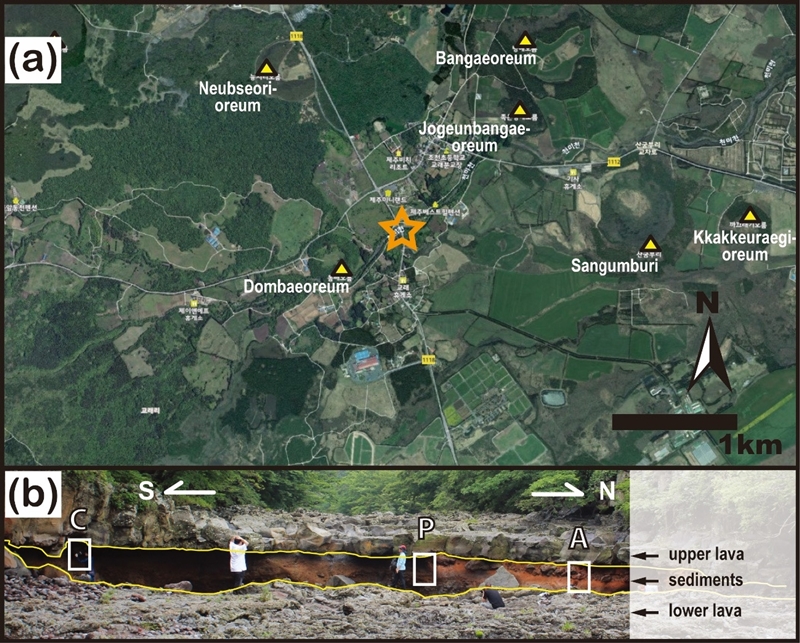
Location map and photo view of the outcrop for the studied site. (a) Satellite map view (modified from the map provided in https://www.vworld.kr/) showing the studied site location (orange star) with its surrounding “oreum” peaks (yellow triangles). (b) A westward view of the sampled outcrop exposed in a pothole on the riverbed, showing contact relationship of two lava beds and the intercalated sedimentary unit (s). The three sedimentary sections (A, P, and C from north to south) studied in Ahn et al. (2018) are also presented as white-line boxes with the labelling.
본 연구논문은 교래교퇴적층의 표식지 노두에 노출한 상하부 용암층의 암석시료로부터 전암주성분자료를 포함한 40Ar/39Ar 수치연대 자료를 통해 Ahn et al. (2018)에서 언급하고 있는 퇴적층 OSL 연대자료로부터 도출한 상부 용암의 추정 수치연대와 그 적용 가능성을 확인하고자 한다.
2. 연구지역 및 선행연구
Ahn et al. (2018) 및 본 연구의 대상지역은 앞서 언급한 제주도 제4교래교 인근에 위치한 노두이다(그림 1a). 그림 1b의 전경 사진은 상하로 구분되는 2매의 용암층과 이들 사이에 있는 니질우세 퇴적층으로 구분되는 것을 보여준다. 이것들은 제주-애월 1:5만 지질도폭 보고서(Park et al., 1998)에 따르면, 아래부터 위로 각각 교래리현무암, 교래교퇴적층, 물장올교현무암으로 명명되어 있다.
Ahn et al. (2018)에서 수행한 분석 절차에 대해 그림 2a에 간략하게 나타낸다. 14C 및 OSL 연대분석은 퇴적물시료로부터 휴믹산(humic acid) 처리로 추출한 흑연을 Kim et al. (2009)의 전처리방법으로 추출한 세립질(4-11 μm) 석영 입자를 각각 이용하여 한국지질자원연구원에서 실험 및 분석을 수행하였다(예: Lee et al., 2014). 자기학적 분석은 피열온도를 정량 복원하는 것을 위한 것으로, 1) 보조적 분석절차(auxiliary protocols: 피열 가능성 여부를 살피는 Koenigsberger (Qn) 비(Stacey, 1967) 및 NRM0/SIRM 비 계산을 위한 분석과, Tpaleo 복원 방법(1)과 방법(2)에 부수적으로 필요한 자연잔류자화 단계교류소자실험(NRM-PAFD)과 단일 대자율 온도변화 분석(single k-T run)을 포함함), 2) 잔류자화(remanent magnetization; remanence) 성분 추출 및 방향 비교분석을 통한 Tpaleo 복원 방법(1)을 위한 분석, 그리고 3) 다중 대자율 온도변화 분석(repeated k-T runs)을 통한 Tpaleo 복원 방법(2)을 위한 분석으로 이루어졌다. Tpaleo 복원방법(1)에서 이용되는 원리는 퇴적물이 용암 정치에 의해 재가열되고 최대도달온도에서 주변온도까지 냉각되면서 당시의 지구자기장 방향과 평행한 열잔류자화(thermoremanent magnetization)를 획득하게 되는데 이는 퇴적물이 원래 가지고 있던 잔류자화 방향과 세기는 구분된다는 것이다. Tpaleo 복원방법(2)에서의 원리는 자연상태에서 한번 어떤 온도 T까지 가열되었다가 주변온도까지 냉각시킨 물질은 열에 대해 안정적인 상태가 되어, T보다 높지 않은 온도로 가열-냉각을 반복하더라도 그 물성(여기서는, 대자율)이 크게 변하지 않는다는 것이다. 이로부터 복원되는 피열온도(heating temperature; 이하, Tpaleo 라 함)는 시료에 포함된 자성입자군의 도달한 최대온도의 평균을 의미한다. 본 자기분석에는 정향 채취해 형태를 유지시킨 토양시료와 막자사발(agate mortar)로 가볍게 분쇄한 분말 시료를 이용하였다: 정향토양시료는 대자율(kLF, kHF) 측정, 잔류자화(NRM0, NRM, SIRM) 측정 및 단계소자실험에, 분말시료는 대자율의 온도변화(k-T) 측정에 이용되었다.
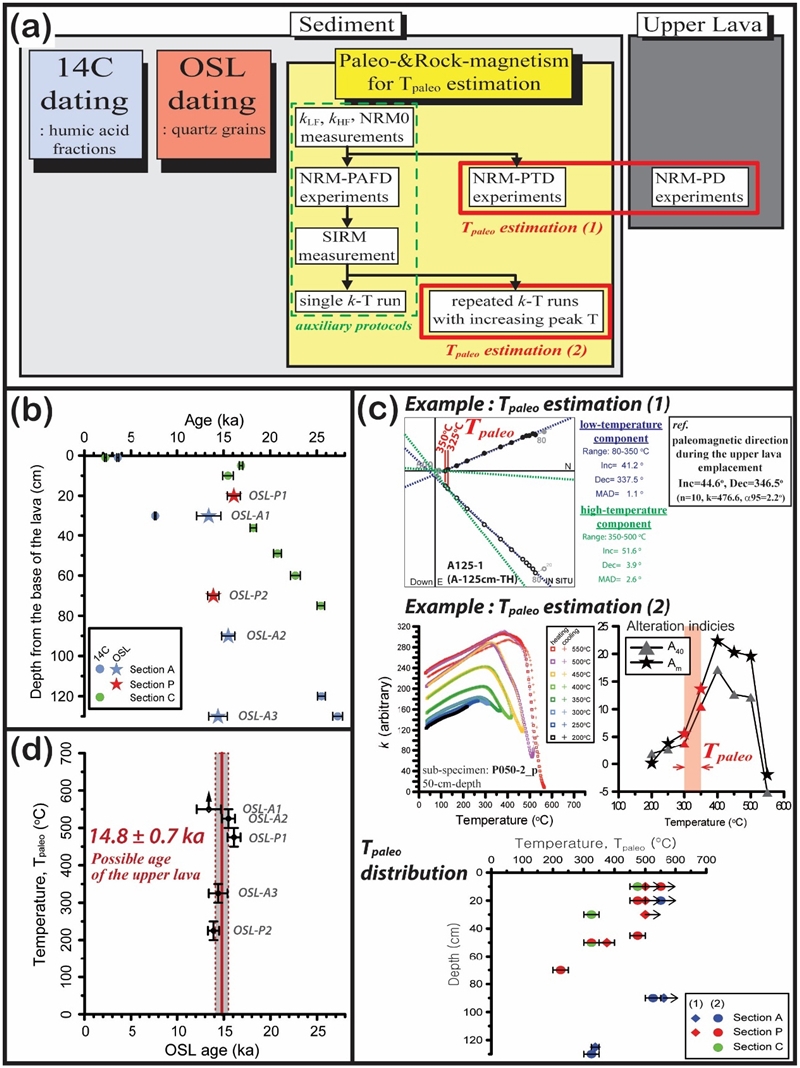
Summary of the experimental protocols used and the results in Ahn et al. (2018). (a) Schematic figure showing the experimental protocols, where 14C and OSL dating, and two different techniques of Tpaleo estimation based on paleo- and rock-magnetic analyses are included. kLF, kHF: low-field magnetic susceptibility with low- and high-frequency, respectively. NRM0, SIRM: initial intensity of natural remanent magnetization and saturation isothermal remanent magnetization, respectively. NRM-PD/PAFD/PTD experiments: progressive demagnetization/alternating field demagnetization/thermal demagnetization experiments for NRMs carried in the samples. k-T run (s): magnetic susceptibility vs. temperature monitoring with single or multiple cycles of heating-cooling with variable peak temperatures. (b) Plot of the estimated 14C and OSL ages for the three sections with depth from the upper lava-sediment contact. The error bars on the “age” axis for 14C and OSL denote ± 2 × {standard deviation} and ± 2 × {standard error}, respectively. The grey-colored letter is the sample code for each of the OSL data. (c) Two examples of results from the two different approaches for Tpaleo estimation (the uppermost- and middle-part figures) and the Tpaleo variation with depth for individual sections (the lowermost-part plot). The estimation technique (1) is based on one of the hypothesis and practice of paleomagnetism through paleomagnetic directional analyses and the technique (2) is based on one of the practical feature of the so-called rock-magnetism (more specifically, magnetic property response of magneto-minerals-bearing materials after annealing). See Ahn et al. (2018) for details. (d) Plot of Tpaleo (derived from the estimation technique (2)) vs. OSL age for five samples with different positions, with a possible age determination of the upper lava emplacement by using them. All the uncertainty limits shown in this figure are ± 2 × {standard error}. The grey-colored letters are same as in (b).
그림 2b는 얻은 14C와 OSL 연대값을 상부용암-퇴적층 접촉부로부터의 깊이에 따라 나타낸 것이다. 같은 지점에서 14C와 OSL 연대값이 서로 상이한 결과가 존재하고 깊이에 따른 연대 변화 프로파일도 또한 상이함을 볼 수 있다: 퇴적층 상부 1.3 m 이내로부터 얻은 OSL 연대값들은 거리에 상관없이 약 15 ka 내외의 값을 지시하는 한편, 14C 연대값들은 최대 약 27 ka에서부터 깊이에 따라 대략적으로 순차적인 연대값을 보이며 가장 젊게는 약 2 ka의 값을 보인다. 이러한 차이는 분석된 연대값들이 단순히 퇴적층의 퇴적연대만을 지시하지 않는 경우에 대해 추가적인 검토의 필요성을 의미한다.
그림 2c는 Tpaleo를 복원한 결과의 예시와 얻은 Tpaleo의 깊이에 따른 분포를 나타낸 것이다. Tpaleo 복원방법(1) 예시의 경우(그림 2c의 상단), 용암 정치 당시의 고지자기와 같은 방향을 갖는 잔류자화 성분을 추출하고 이 성분이 최대 350℃의 열소자에 의해 세척됨을 알 수 있다. 이 경우, Tpaleo는 325-350℃(열소자단계를 고려함)로 복원된다. Tpaleo 복원방법(2) 예시의 경우(그림 2c의 중단), 피크온도(peak temperature)를 단계적으로 올려 다단계 k-T 분석결과로부터 피크온도 300℃와 350℃ 사이에서 가열-냉각 간의 대자율 차이가 급격히 커짐(즉, alteration index의 급격한 상승)을 알 수 있다. 이 경우 Tpaleo는 300-350℃로 복원된다. 같은 깊이에서 두 온도복원방법으로부터 얻은 Tpaleo값은 대체로 서로 일치하는 한편, 복원방법(1)로 얻은 Tpaleo값이 복원방법(2)의 결과보다 50℃ 내외로 높은 경우도 확인된다(그림 2c 하단). 이러한 차이는 자화획득에 관한 Néel이론(Néel, 1949)으로부터 예측되는 “냉각속도 효과”에 기인하는 것으로 해석된다(예: Dodson and McClelland-Brown, 1980). 즉, 복원방법(1)실험 중 시료를 가열 후 식히는 속도가 실제 용암이 자연계에서 식는 속도보다 빨라 차이를 보이는 관계로 특정온도에서 주변온도로의 냉각으로 획득한 자화를 세척하는데 그 특정온도보다 더 높은 온도가 필요하다. 이 “냉각속도 효과”에 따른 자화 획득 및 세척의 온도 차이는 400℃이상의 가열에서는 약 40℃이내로 낮아진다. 깊이에 따른 Tpaleo 변화 프로파일(그림 2c 하단)은 단면에 따라 다양한 감소 양상을 보이나 공통적으로 상부 용암(고열원)으로부터의 열 전달에 의한 것으로 볼 수 있다. 단면 A 및 P에서는 얻은 Tpaleo=400℃의 등온선(isotherm)이 적색 퇴적층 분포의 하한과 대략 일치함이 관찰된다. 다만, 퇴적층의 색깔(즉, redness)이 피열 유무를 알 수 있는 척도로 보조적으로 활용할 수는 있으나 적색 퇴적층과 피열사건이 필요충분조건의 관계가 아님을 주지할 필요가 있다.
그림 2d는 OSL 수치연대와 Tpaleo의 관계를 나타낸 것이다. 약 15 ka에 집중되어 있는 OSL 연대를 얻은 5개 지점의 시료들은 200-250℃ 이상의 고온를 경험하였음을 나타낸다. 이는 퇴적물의 퇴적·매몰 후로부터 획득해 온 OSL신호가 상부 용암으로부터 전달된 열에 의해 OSL신호가 리셋되었음을 지지한다. OSL-P2시료의 200-250℃ 온도는 OSL신호 리셋에는 충분치 않은 것처럼 보일 수 있는데, 용암으로부터 인접한 규산염암체로의 열전달을 생각했을 때 비슷한 온도에 도달한 후 온도는 근접한 범위에서 102 시간 이상에 걸쳐 지속될 수 있다는 점을 고려한다면 OSL신호 리셋은 타당한 것으로 생각된다. 또한, 경험적으로 200℃이상의 가열에 루미네선스 신호가 소멸된다는 보고가 있으며(예: Duller, 2004), Chruścińska (2009)는 컴퓨터 시뮬레이션을 통해 180℃ (453 K)에 OSL신호의 완전한 열적 리셋이 가능하다고 예측하였다. 향후 루미네선스의 열적 리셋을 고려할 경우에는 가열온도 뿐아니라 가열지속시간도 또한 중요한 요소 중 하나이며 앞으로 열적 리셋에 대한 가열온도-지속시간 관계를 규명하는 연구가 절실히 요구된다. 5개 OSL연대값들의 분산은 퇴적층시료에 포함된 암편들의 종류, 구성비율, 분포의 차이에서 비롯한 평균방사능의 차이에 기인하는 것으로 추정한다. 이러한 영향은 다양한 조건의 시료들로부터 얻은 다수의 OSL 연대값을 평균함으로써 상쇄시킬 수 있을 것으로 판단된다. 5개 OSL연대값들에 대한 가중평균 및 오차 계산으로부터 14.8 ± 0.7 ka (2 × 표준오차 기준; 1 × 표준편차 기준으로 ± 0.8 ka에 해당함)을 얻을 수 있고, 이 값은 상대적으로 낮은 온도(200-250℃)를 경험한 OSL-P2 자료를 제외한 4개 자료에 대한 가중평균 및 오차인 15.3 ± 0.7 ka (2 × 표준오차 기준)와 통계적으로 유의미한 차이를 보이지 않는다. 본 연구지역에서 퇴적층 OSL 연대는 퇴적 연대가 아닌 용암 정치 연대를 지시한다고 해석하는 것이 합리적임을 제안한다.
3. 시료 및 분석 방법
노두의 상부 및 하부의 용암층으로부터 각각 블록 형태로 암석시료를 채취하였다. 채취한 상부 용암 시료는 HL1064, 하부 용암 시료는 HL1065로 명명하였다.
암석 블록의 일부를 파쇄하여 준비한 시료에 대해 한국지질자원연구원의 시마즈 MXF-2400 기종의 X-선 형광분광분석(XRF)을 이용하여 전암 주성분원소(major elements) 분석을 수행하였다.
40Ar/39Ar 연대 분석은 분석시료로는 전암의 석기(groundmass)를 준비하여 단계가열법을 통해 이루어졌다. 미국 오레곤 대학의 원자로를 이용하여 중성자 조사(neutron irradiation)를 실시하였으며, 한국기초과학지원연구원(KBSI)의 레이저 발생장치(Fusions 10.6 laser heating system, Photon Machines)와 다검출기 불활성기체 질량분석장비(ARGUS VI noble gas mass spectrometer, Thermo)를 이용하여 시료의 가열과 Ar 동위원소 측정을 실시하였다. 자세한 시료 준비, 실험 절차, 그리고 연대 계산에 대해서는 Kim et al. (2005)와 Kim and Cho (2020)를 참고 바란다. 중성자 조사(neutron irradiation)와 J값 측정(연대 계산에 활용됨)에는 표준물질 Alder Creek sanidine (ACS; 1.193 ± 0.001 Ma; Nomade et al. (2005))을 이용하였다. 연대 계산에 필요한 40K의 붕괴상수들은 Steiger and Jäger (1977)의 자료를 이용하였다. 연대값은 단계별 가열에 따른 40Ar/39Ar 연대스펙트럼(age spectrum)으로부터 플래토(plateau) 연대를 계산하여 제시하였다. 분석결과에 대한 오차는 모두 1 × 표준편차(standard deviation)로 나타내었다.
4. 결과 및 토의
교래교퇴적층의 상부 용암과 하부용암은 서로 다른 산상을 나타낸다. 상부 용암은 기공이 거의 없고 매우 치밀하며 반정이 거의 없으며, 하부 용암은 기공이 많은 편으로 5 mm 내외의 사장석이 반정으로 산출되는 것이 특징이다(그림 3). 그림 4는 전암 주성분원소 함량(표 1)으로 알칼리(Na2O+K2O) 대 이산화규소(SiO2) 함량 화산암 분류도(Le Maitre et al., 2002)에 적용하여 나타낸 것이다. 이에 따르면 HL1064는 현무암질 조면안산암(basaltic trachyandesite)으로, HL1065는 전이질 현무암(transitional basalt)으로 분류된다.
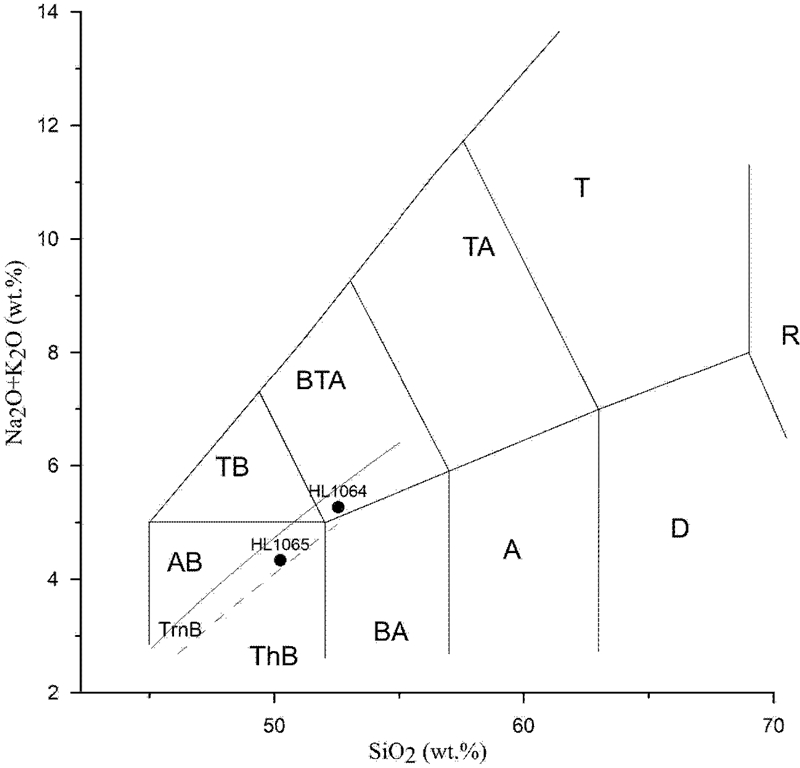
Total alkali vs. silica (TAS) diagram (Le Maitre et al., 2002) for the two studied lava samples (solid circles). The thin solid and dashed lines represent the boundaries dividing between alkaline and sub-alkaline compositions by Irvine and Baragar (1971) and by Macdonald and Katsura (1964), respectively. Abbreviations - AB: alkali basalt; TrnB: trasitional basalt; ThB: tholeiitic basalt; TB: trachybasalt; BTA: basaltic trachyandesite; BA: basaltic andesite; TA: tracyandesite; T: trachyte; A: andesite; D: dacite; R: rhyolite. The two data presented are from Table 1.

Major element abundances (in wt%) and rock classification of the studied lava rock samples (HL1064, HL1065). The analyses were made by XRF at KIGAM. Fe2O3*: total Fe as Fe2O3. LOI: loss on ignition. The rock type is determined by Le Maitre et al. (2002) (see Fig. 3); BTA: basaltic trachyandesite, TrnB: transitional basalt.
두 시료 HL1064와 HL1065에 대한 40Ar/39Ar 연대분석 결과를 표 2와 그림 5에 요약하여 제시한다. HL1064의 단계가열 연대스펙트럼을 보면 39Ar 가스 추출량의 처음 0.8%의 저온부에서 젊은 연대로 치우치는 것을 제외하고 대체로 안정적인 플래토를 이룬다. 따라서, 99.2%의 플래토 영역을 채택하여 15 ± 5 ka (MSWD= 0.9)의 플래토 연대를 얻는다. HL1065의 연대스펙트럼은 각 단계별 겉보기 연대축에 대한 분석오차가 대체로 약간 큰 편이고, 겉보기에 39Ar 추출량의 처음 60.6%와 그 이후의 추출량에 대해 서로 다른 플래토를 형성하는 듯하다. 단일 분석결과만으로 속단하기 어려우나 단계가열 저온부 초기와 고온부의 겉보기연대가 오래된 쪽으로 치우치는 경향을 과잉 40Ar의 영향으로 추정한다면, 저온부 60.6%의 영역으로부터 연대를 계산하는 것이 타당할 것이다. 따라서, HL1065의 플래토 연대는 310 ± 30 ka (MSWD= 1.3)로 도출된다.

Summary of 40Ar/39Ar step heating results. See also Fig. 5 for the corresponding age spectrum diagrams.
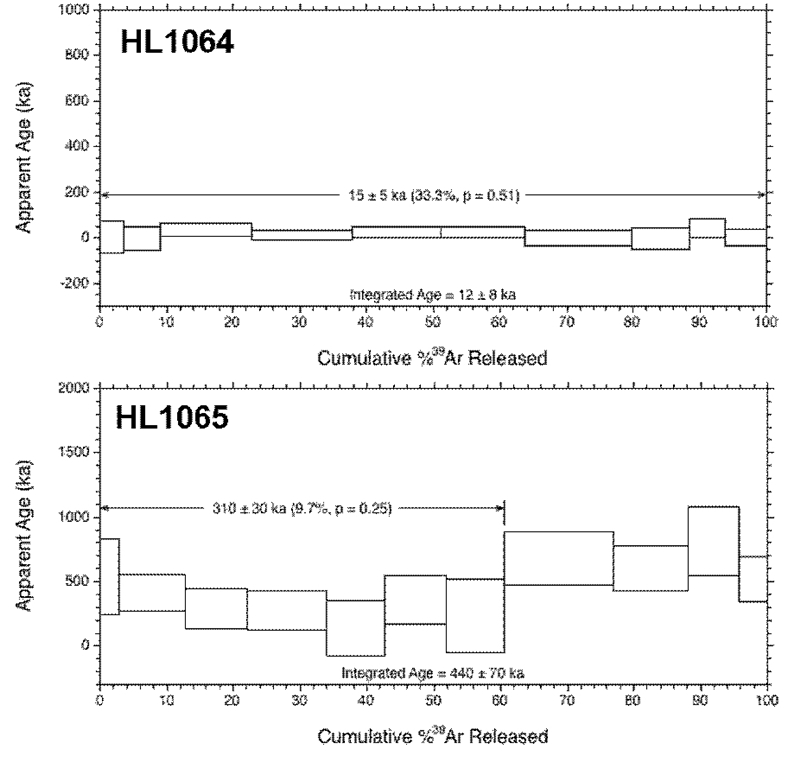
40Ar/39Ar age spectrum diagrams for the two samples, HL1064 (the upper lava) and HL1065 (the lower lava). The line with arrows in each diagram denotes plateau steps used in age calculations.
상부 용암의 40Ar/39Ar 연대결과(15 ± 5 ka)는 OSL연대 자료들을 토대로 도출한 수치연대(14.8 ± 0.8 ka)와 일치한다(그림 6). 이 사실은 일정온도 이상으로 가열된 퇴적물에 포함한 석영 입자들은 용암 피복에 의해 OSL신호가 리셋되었으며 인접퇴적층의 OSL 연대분석을 통해 용암의 수치연대를 제시할 수 있음을 뒷받침한다. 또한, 개개의 도출 연대에 대한 오차를 비교해 보면 40Ar/39Ar 연대는 OSL 연대에 비해 약 3배이상의 큰 오차를 갖는 것으로 보여(그림 6), OSL 접근법의 실효성을 살필 수 있다.
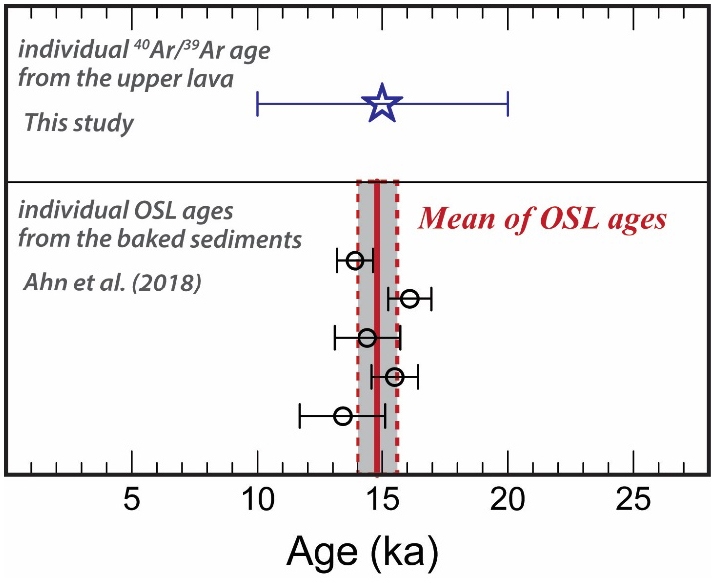
Comparison of the preferred 40Ar/39Ar plateau age of this study and the mean derived from individual OSL ages by Ahn et al. (2018) for age determination of the upper lava, showing a good consistency. All the errors in age are given as ± 1 × {standard deviation}.
상부 용암의 약 15 ka 연대값은, Ahn et al. (2018)에서 보고한 교래교퇴적층의 14C 연대결과 중 약 15 ~ 27 ka의 깊이에 따른 순차적인 연대분포와도 조화로운 결과이며, 이 15 ~ 27 ka의 14C 연대는 교래교퇴적층의 퇴적연대를 지시할 가능성이 높다. 한편, 단면 A와 P의 상부 30 cm이내의 퇴적물로부터 얻은 14C 연대는 매우 15 ka에 비해 매우 젊게 나타난다. 이것은 단면 A와 P는 상대적으로 균질하고 투수성이 낮은 니질퇴적층으로 형성된 단면 C와는 달리 상부 약 30 ~ 60 cm 내에 모래 또는 거력 크기의 입자들이 많이 포함되어 불균질한 입자분포를 보이고 공극이 많은 점을 보아, 현생 탄소(modern carbon)의 혼입에서 기인되는 것으로 해석된다.
상부 용암은 물장올교현무암으로 알려져 있는데, 지질도폭에 물장올교현무암으로 명명된 범위 내로부터 기존에 보고된 연대자료로, 54 ± 18(2 × 표준편차 기준) ka (전암 40Ar/39Ar 플래토연대; SDS-1공(33.42222°N, 126.66535°E)의 최상부 용암층, Koh et al., 2013)와 56.4 ± 3.0(2 × 표준편차 기준) ka (전암 석기 40Ar/39Ar 연대; 물장올교 인근 하천변 용암; 미발표자료, 고기원: Koh et al. (2019)에 언급됨)이 있다. 이들 수치연대는 본 연구 연대결과보다 뚜렷하게 오래된 시기를 가리킨다. 추가로, 이 용암들은 화산암 분류도에 따르면 지질도폭설명서(Park et al., 1998)에서 제공하는 자료는 조면현무암과 현무암질 조면안산암으로, SDS-1공의 최상부 용암은 조면현무암으로 분류되며, 본 연구의 상부 용암은 현무암질 조면안산암으로 분류된다. 즉, 서로 다른 수치연대를 갖는 용암들은 서로 다른 조성을 갖는다. 따라서, 본 연구의 상부용암은 기존에 연대가 보고된 노두의 “물장올교현무암” 용암과는 다른 독립된 용암체일 가능성이 매우 높다.
하부 용암의 40Ar/39Ar 연대(310 ± 30 ka)는 상부 용암의 연대와 교래교퇴적층의 하한 연대보다 오래된 것으로 나타나 노두 내에서는 모순되지 않는 결과이다. 하부 용암은 교래리현무암으로 알려져 있는데, 교래리현무암의 수치연대는 아직까지 보고되지 않았다. 이 외에 연대 비교대상으로는, 본 연구지점으로부터 남서쪽으로 약 1.1 km 떨어진 SDS-1공의 최상부 용암층(지질도폭에 물장올교현무암으로 표기된 지점임)의 연대가 54 ± 18(2 × 표준편차 기준) ka이고, 동쪽으로 약 4.8 km 떨어진 GYR공(33.42774 °N, 126.72487°E; Koh et al., 2013; 지질도폭에 대천동현무암으로 표기된 지점임)의 최상부용암으로부터는 40Ar/39Ar 연대를 얻지 못하였으나 그 하위에 있는 용암 연대가 71 ± 11(2 × 표준편차 기준) ka이다. 야외관찰에 따르면 이 주변의 용암류 선후관계는 오래된 것부터 대천동현무암, 교래리현무암, 물장올교현무암의 순이다(Park et al., 1998). 따라서, 본 연구에서 얻은 약 310 ka 연대는 용암층 선후관계에 근거하면 GYR공의 71 ± 11 ka 연대와 모순적인 듯하다. 앞서 결과에 언급하였듯이, HL1065시료의 연대 계산에 있어 상대적으로 불안정한 플래토를 형성한 것을 고려한다면, 약 310 ka 연대값은 주어진 분석오차보다 큰 정확도에 대한 불확실성이 있을 수 있다는 점을 배제할 수 없으므로 확립된 수치연대보다는 참고 자료로 활용하는 정도가 현재로서는 타당하리라 본다. 앞으로, 다수의 시료로부터의 40Ar/39Ar 분석을 통한 연대 재검토뿐 아니라, 직하부에 인접한 퇴적층을 찾는다면 Ahn et al. (2018)의 프로토콜을 이용한 연대 도출도 기대할 만하다.
원리적으로는 고온으로 정치된 화산분출물(뿐만 아니라 관입맥상 화성암체까지 확장가능함)의 경우 Ahn et al. (2018)에서 제시한 것과 유사한 방법을 적용하여 그 화산분출물이 정치되기 이전부터 존재하는 인접한 퇴적층을 이용한 OSL 연대분석을 통해 화산분출물의 수치연대를 직접 구할 수 있을 것이다. 다만, 화산분출물로부터 접촉하고 있는 퇴적층으로의 열전달은 다양한 요소(예를 들어, 화산분출물의 초기 정치온도, 화산분출물-퇴적층 접촉부의 상태, 퇴적층의 입도분포, 공극 비율 및 분포, 함수비율 등)에 의해 좌우되어 퇴적층의 피열(도달)온도 프로파일이 결정되므로, 퇴적물 내 피열온도 정량 복원이 필수적이다. Ahn et al. (2018)은 자기학적으로 구한 온도 Tpaleo와 OSL신호 리셋의 관계를 확립할 수 있는 단계까지는 도달하지 못하였으나, 사례적으로 OSL신호의 열적 리셋이 가능한 피열 도달온도의 최소값으로서 200-250℃를 제시하였다. 화산분출물 중, 용암류, 육상 마그마성 화산분화로부터 형성되는 분화구 근접부의 화쇄류 또는 스코리아 등은 대체로 이보다 충분히 높은 온도에 정치하게 되므로 연대도출 적용대상으로서 매력적이다(예: Lee et al. (2014)의 상창리 용암, Ahn and Choi (2016)의 조천곶자왈 용암, 교래곶자왈 용암, 애월곶자왈 용암, Ahn et al. (2017)의 거문오름 용암 및 스코리아, Yeo et al. (2019)의 체오름 용암과 둔지오름 용암). 특히 Ahn et al. (2017)를 살펴보면, 거문오름의 용암층 및 스코리아층 하부의 고토양층으로부터 얻은 14C와 OSL 연대 간에 OSL 연대가 14C 연대보다 일관되게 젊게 나타나는데 OSL 연대가 거문오름 형성 연대를 직접 지시할 가능성을 제기할 수 있을 것이다. 하지만 한편으로는, Ahn et al. (2017)와 Yeo et al. (2019)에서 관찰되듯이, 석영의 조립질 입자와 세립질 입자로부터 얻은 OSL 수치연대가 차이를 보인다는 점은 OSL 연대분석을 통한 수치연대 결정에 적지 않은 불확실도를 초래할지도 모른다. 이외에도, Yeo et al. (2019)는 퇴적층 내 OSL 수치연대 간 층서관계의 흐트러짐을 관찰하였는데 이 원인의 가능성으로 추출한 석영입자의 상대적으로 낮은 OSL신호 감도와 퇴적물 내 생물교란 작용을 제시하기도 하였다. Ahn et al. (2018)의 수치연대 도출방법을 확립하고 널리 활용하기 위해서 위에 언급한 문제점 등을 파악하고 개선할 수 있는 체계적인 연구 수행이 앞으로의 과제이다.
5. 결 론
본 연구논문은 제주시 조천읍 교래리의 제4교래교 인근 노두에서 교래교퇴적층과 접촉하고 있는 상부 용암층(“물장올교현무암”에 해당함)으로부터 전암 석기의 단계가열법을 통한 40Ar/39Ar 연대분석을 통해 플래토 연대 15 ± 5 ka를 도출하였다. 이 40Ar/39Ar 연대는 Ahn et al. (2018)에서 인접 피열퇴적층 OSL 연대분석으로부터 제시한 상부 용암의 수치연대(14.8 ± 0.8 ka)와 잘 일치하는 것으로 Ahn et al. (2018)이 제시한 수치연대 도출방법의 적용 가능성을 증명한다. 또한 본 연구 결과인 약 15 ka의 “물장올교현무암” 수치연대는, 기존에 다른 노두에서 보고된 오래된(약 56 ka?) “물장올교현무암”과는 다른 또 하나의 독립된 용암류의 존재의 가능성을 시사한다. 앞으로, 제주도의 최후기 화산활동사와 관련해 후기 플라이스토세-홀로세 동안의 용암류(뿐만 아니라 고열원인 다른 화산분출물)의 수치연대를 새롭게 제시하는데 퇴적층 OSL 연대분석 및 피열온도 정량 복원이 크게 기여할 것이라 기대한다.
Acknowledgments
본 연구의 40Ar/39Ar 연대 분석에 애를 써 주신 한국기초과학지원연구원 김정민 박사님께 감사의 뜻을 전합니다. 본 연구는 한국지질자원연구원 주요사업과제(국토 지질조사 및 지질도·지질주제도 발간-GP2020-003)의 지원을 받아 수행되었습니다. 논문의 초고에 건설적인 지적 및 의견과 함께 세심한 심사를 해 주신 미육군극동공병단의 박준범 박사님과 한국기초과학지원연구원의 최정헌 박사님, 그리고 논문 편집에 애를 써 주신 편집위원장님과 편집위원님께 감사드립니다.
References
-
Ahn, H.-S., Kim, J.C., Lee, J.-Y., Lim, J., Sohn, Y.K. and Cho, H., 2018, Magnetic assessment of OSL and radiocarbon ages of sediments beneath a lava in Jeju Island, Korea: Implication of possible resetting of OSL signals and age constraint of the late Quaternary lava. Quaternary Geochronology, 48, 45-63.
[https://doi.org/10.1016/j.quageo.2018.07.012]

-
Ahn, U.S. and Choi, H.S., 2016, Very young Gotjawal lavas (aged< ca. 10 ka) on Jeju Island, Korea: The major causes of Gotjawal formation. Journal of the Geological Society of Korea, 52, 433-441 (in Korean with English abstract).
[https://doi.org/10.14770/jgsk.2016.52.4.433]

-
Ahn, U.S., Choi, J.-H. and Yeo, E.-Y., 2017, Eruption timing of the Geomun Oreum through the comparison of radiocarbon and quartz OSL ages. Journal of the Geological Society of Korea, 53, 367-376 (in Korean with English abstract).
[https://doi.org/10.14770/jgsk.2017.53.3.367]

-
Ahn, U.S., Sohn, Y.K., Kang, S.S., Jeon, Y.M. and Choi, H.S., 2015, The major causes of Gotjawal formation in Jeju Island. Journal of the Geological Society of Korea, 51, 1-19 (in Korean with English abstract).
[https://doi.org/10.14770/jgsk.2015.51.1.1]

-
Bebbington, M.S., 2020, Temporal-volume probabilistic hazard model for a supervolcano: Taupo, New Zealand. Earth and Planetary Science Letters, 536, 116141.
[https://doi.org/10.1016/j.epsl.2020.116141]

-
Bebbington, M.S. and Cronin, S.J., 2011, Spatio-temporal hazard estimation in the Auckland Volcanic Field, New Zealand, with a new event-order model. Bulletin of Volcanology, 73, 55-72.
[https://doi.org/10.1007/s00445-010-0403-6]

-
Brenna, M., Cronin, S.J., Kereszturi, G., Sohn, Y.K., Smith, I.E.M. and Wijbrans, J., 2015, Intraplate volcanism influenced by distal subduction tectonics at Jeju Island, Republic of Korea. Bulletin of Volcanology, 77, 7.
[https://doi.org/10.1007/s00445-014-0896-5]

-
Cheong, C.S., Choi, J.H., Sohn, Y.K., Kim, J.C. and Jeong, G.Y., 2007, Optical dating of hydromagmatic volcanoes on the southwestern coast of Jeju Island, Korea. Quaternary Geochronology, 2, 266-271.
[https://doi.org/10.1016/j.quageo.2006.05.002]

-
Chernyshev, I.V., Lebedev, V.A. and Arakelyants, M.M., 2006, K-Ar dating of quaternary volcanics: Methodology and interpretation of results. Petrology, 14, 62-80.
[https://doi.org/10.1134/S0869591106010061]

-
Chruścińska, A., 2009, Modelling the thermal bleaching of OSL signal in the case of a competition between recombination centres. Radiation Measurements, 44, 329-337.
[https://doi.org/10.1016/j.radmeas.2009.04.007]

-
Dodson, M.H. and McClelland-Brown, E., 1980, Magnetic blocking temperatures of single-domain grains during slow cooling. Journal of Geophysical Research, 85(B5), 2625-2637.
[https://doi.org/10.1029/JB085iB05p02625]

-
Duller, G., 2004, Luminescence dating of Quaternary sediments: recent advances. Journal of Quaternary Science, 19, 183-192.
[https://doi.org/10.1002/jqs.809]

-
Fattahi, M. and Stokes, S., 2003, Dating volcanic and related sediments by luminescence methods: a review. Earth-Science Reviews, 62, 229-264.
[https://doi.org/10.1016/S0012-8252(02)00159-9]

-
Holdaway, R.N., Duffy, B. and Kennedy, B., 2018, Evidence for magmatic carbon bias in 14C dating of the Taupo and other major eruptions. Nature Communications, 9, 4110.
[https://doi.org/10.1038/s41467-018-06357-0]

-
Irvine, T.N. and Baragar, W.R.A., 1971, A guide to the chemical classification of the common volcanic rocks. Canadian Journal of Earth Sciences, 8, 523-548.
[https://doi.org/10.1139/e71-055]

-
Kim, J. and Cho, I.-H., 2020, Improvement of 40Ar/39Ar age determinations for Quaternary basaltic rocks by eliminating the peak suppression effect. Journal of Analytical Science and Technology, 11, 9.
[https://doi.org/10.1186/s40543-020-00207-9]

-
Kim, J.C., Roberts, H.M., Duller, G.A.T., Lee, Y.I. and Yi, S.B., 2009, Assessment of diagnostic tests for evaluating the reliability of SAR De values from polymineral and quartz fine grains. Radiation Measurements, 44, 149-157.
[https://doi.org/10.1016/j.radmeas.2009.01.003]

- Kim, J.-S., Son, M., Kim, J.-S. and Kim, J., 2005, 40Ar/39Ar ages of the Tertiary dike swarm and volcanic rocks, SE Korea. The Journal of the Petrological Society of Korea, 14, 93-107 (in Korean with English abstract).
- Koh, G.W., 1997, Characteristics of the Groundwater and Hydrogeologic Implications of the Seoguipo Formation in Cheju Island. Ph.D. thesis, Pusan National University, Pusan, 326 p (in Korean with English abstract).
-
Koh, G.W., Park, J.B., Hong, S.S., Ko, I.J. and Kim, T.H., 2019, Multiple volcanic eruption episodes in the highlands of Mt. Halla (Hallasan), Jeju Island, Korea: 40Ar/39Ar ages of lava flows. Journal of the Geological Society of Korea, 55, 71-86 (in Korean with English abstract).
[https://doi.org/10.14770/jgsk.2019.55.1.71]

- Koh, G.W., Park, J.B., Kang, B.-R., Kim, G.-P. and Moon, D.C., 2013, Volcanism in Jeju Island. Journal of the Geological Society of Korea, 49, 209-230 (in Korean with English abstract).
-
Korte, M., Brown, M.C., Gunnarson, S.R., Nilsson, A., Panovska, S., Wardinski, I. and Constable, C.G., 2019, Refining Holocene geochronologies using palaeomagnetic records. Quaternary Geochronology, 50, 47-74.
[https://doi.org/10.1016/j.quageo.2018.11.004]

-
Kuntz, M.A., Spiker, E.C., Rubin, M., Champion, D.E. and Lefebvre, R.H., 1986, Radiocarbon studies of latest Pleistocene and Holocene lava flows of the Snake River Plain, Idaho: Data, lessons, interpretations. Quaternary Research, 25, 163-176.
[https://doi.org/10.1016/0033-5894(86)90054-2]

-
Le Maitre, R.W., Streckeisen, A., Zanettin, B., Le Bas, M., Bonin, B., Bateman, P., Bellieni, G., Dudek, A., Efremova, S., Keller, J., Lameyre, J., Sabine, P.A., Schmid, R., SØrensen, H. and Woolley, A.R., 2002, Igneous rocks: A classification and glossary of terms. In: Le Maitre, R.W. (ed.), Recommendations of the International Union of Geological Sciences, Subcommission on the Systematics of Igneous rocks, 2nd Edition. Cambridge University Press, Cambridge, 236 p.
[https://doi.org/10.1017/CBO9780511535581]

-
Lee, J.-Y., Kim, J.C., Park, J.B., Lim, J., Hong, S.S. and Choi, H., 2014, Age of volcanic activity from Quaternary deposits in Sangchang-ri, Jeju island, Korea. Journal of the Geological Society of Korea, 50, 697-706 (in Korean with English abstract).
[https://doi.org/10.14770/jgsk.2014.50.6.697]

-
Leonard, G.S., Calvert, A.T., Hopkins, J.L., Wilson, C.J.N., Smid, E.R., Lindsay, J.M. and Champion, D.E., 2017, High-precision 40Ar/39Ar dating of Quaternary basalts from Auckland Volcanic Field, New Zealand, with implications for eruption rates and paleomagnetic correlations. Journal of Volcanology and Geothermal Research, 343, 60-74.
[https://doi.org/10.1016/j.jvolgeores.2017.05.033]

-
Lim, J., Lee, J.-Y., Kim, J.C., Hong, S.S. and Choi, H., 2015, Paleoenvironmental and volcanologic implications of the Gosan Formation in Jeju Island, Korea. Journal of the Geological Society of Korea, 51, 537-544 (in Korean with English abstract).
[https://doi.org/10.14770/jgsk.2015.51.6.537]

-
Lim, J., Matsumoto, E. and Kitagawa, H., 2005, Eolian quartz flux variations in Cheju Island, Korea, during the last 6500 yr and a possible Sun-monsoon linkage. Quaternary Research, 64, 12-20.
[https://doi.org/10.1016/j.yqres.2005.02.012]

-
Macdonald, G.A. and Katsura, T., 1964, Chemical compositon of Hawaiian Lavas. Journal of Petrology, 5, 82-133.
[https://doi.org/10.1093/petrology/5.1.82]

-
Mahgoub, A.N., Böhnel, H., Siebe, C., Salinas, S. and Guilbaud, M.-N., 2017, Paleomagnetically inferred ages of a cluster of Holocene monogenetic eruptions in the Tacámbaro-Puruarán area (Michoacán, México): Implications for volcanic hazards. Journal of Volcanology and Geothermal Research, 347, 360-370.
[https://doi.org/10.1016/j.jvolgeores.2017.10.004]

-
Manning, S.W. and Kromer, B., 2012, Considerations of the scale of radiocarbon offsets in the east Mediterranean, and considering a case for the latest (most recent) likely date for the Santorini eruption. Radiocarbon, 54, 449-474.
[https://doi.org/10.1017/S0033822200047202]

-
Mizota, C., Endo, H., Um, K.T., Kusakabe, M., Noto, M. and Matsuhisa, Y., 1991, The eolian origin of silty mantle in sedentary soils from Korea and Japan. Geoderma, 49, 153-164.
[https://doi.org/10.1016/0016-7061(91)90098-E]

- Néel, L., 1949, Théorie du traînage magnétique des ferromagnétiques en grains fins avec application aux terres cuites. Annales de Géophysique, 5, 99-136.
-
Nomade, S., Renne, P.R., Vogel, N., Deino, A.L., Sharp, W.D., Becker, T.A., Jaouni, A.R. and Mundil, R., 2005, Alder Creek sanidine (ACs-2): A Quaternary 40Ar/39Ar dating standard tied to the Cobb Mountain geomagnetic event. Chemical Geology, 218, 315-338.
[https://doi.org/10.1016/j.chemgeo.2005.01.005]

-
Oppenheimer, C., Wacker, L., Xu, J., Galván, J.D., Stoffel, M., Guillet, S., Corona, C., Sigl, M., Di Cosmo, N., Hajdas, I., Pan, B., Breuker, R., Schneider, L., Esper, J., Fei, J., Hammond, J.O.S. and Büntgen, U., 2017, Multi-proxy dating the ‘Millennium Eruption’ of Changbaishan to late 946 CE. Quaternary Science Reviews, 158, 164-171.
[https://doi.org/10.1016/j.quascirev.2016.12.024]

- Park, K.H., Song, K.Y., Hwang, J.H., Lee, B.-J., Cho, D.L., Kim, J.C., Cho, B.W., Kin, Y.B., Choi, P.-Y., Lee, S.-R. and Choi, H.I., 1998, Geologic report of the Jeju-Aewol sheet (1:50,000). Korea Institute of Geology, Mining and Materials, 290 p (in Korean with English abstract).
-
Schmidt, C., Schaarschmidt, M., Kolb, T., Büchel, G., Richter, D. and Zöller, L., 2017, Luminescence dating of Late Pleistocene eruptions in the Eifel Volcanic Field, Germany. Journal of Quaternary Science, 32, 628-638.
[https://doi.org/10.1002/jqs.2961]

-
Schmincke, H.-U., 2007, The Quaternary volcanic fields of the East and West Eifel (Germany), In: Ritter, J.R.R., Christensen, U.R. (Eds.), Mantle Plumes: A Multidisciplinary Approach. Springer Berlin Heidelberg, Berlin, Heidelberg, 241-322.
[https://doi.org/10.1007/978-3-540-68046-8_8]

-
Sohn, Y.K., Park, J.B., Khim, B.K., Park, K.H. and Koh, G.W., 2003, Stratigraphy, petrochemistry and Quaternary depositional record of the Songaksan tuff ring, Jeju Island, Korea. Journal of Volcanology and Geothermal Research, 119, 1-20.
[https://doi.org/10.1016/S0377-0273(02)00302-5]

-
Soter, S., 2011, Radiocarbon anomalies from old CO2 in the soil and canopy air. Radiocarbon, 53, 55-69.
[https://doi.org/10.1017/S0033822200034354]

-
Stacey, F.D., 1967, The Koenigsberger ratio and the nature of thermoremanence in igneous rocks. Earth and Planetary Science Letters, 2, 67-68.
[https://doi.org/10.1016/0012-821X(67)90174-4]

-
Steiger, R.H. and Jäger, E., 1977, Subcommission on geochronology: convention on the use of decay constants in geo-and cosmochronology. Earth and planetary science letters, 36, 359-362.
[https://doi.org/10.1016/0012-821X(77)90060-7]

-
Tsukamoto, S., Duller, G.A.T., Wintle, A.G. and Muhs, D., 2011, Assessing the potential for luminescence dating of basalts. Quaternary Geochronology, 6, 61-70.
[https://doi.org/10.1016/j.quageo.2010.04.002]

-
Yeo, E., Choi, J., Ahn, U.S. and Cheong, A.C., 2019, Quartz OSL dating of palaeosols intercalated with basaltic lava flows and scoria deposits from monogenetic volcanoes in northeastern Jeju Island, Korea. Geosciences Journal, 23, 881-894.
[https://doi.org/10.1007/s12303-019-0010-2]


